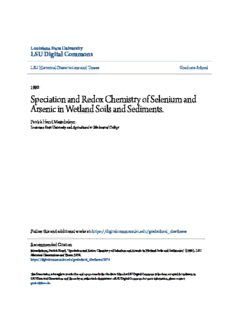
Speciation and Redox Chemistry of Selenium and Arsenic in Wetland Soils and Sediments. PDF
Preview Speciation and Redox Chemistry of Selenium and Arsenic in Wetland Soils and Sediments.
LLoouuiissiiaannaa SSttaattee UUnniivveerrssiittyy LLSSUU DDiiggiittaall CCoommmmoonnss LSU Historical Dissertations and Theses Graduate School 1990 SSppeecciiaattiioonn aanndd RReeddooxx CChheemmiissttrryy ooff SSeelleenniiuumm aanndd AArrsseenniicc iinn WWeettllaanndd SSooiillss aanndd SSeeddiimmeennttss.. Patrick Henri Masscheleyn Louisiana State University and Agricultural & Mechanical College Follow this and additional works at: https://digitalcommons.lsu.edu/gradschool_disstheses RReeccoommmmeennddeedd CCiittaattiioonn Masscheleyn, Patrick Henri, "Speciation and Redox Chemistry of Selenium and Arsenic in Wetland Soils and Sediments." (1990). LSU Historical Dissertations and Theses. 5076. https://digitalcommons.lsu.edu/gradschool_disstheses/5076 This Dissertation is brought to you for free and open access by the Graduate School at LSU Digital Commons. It has been accepted for inclusion in LSU Historical Dissertations and Theses by an authorized administrator of LSU Digital Commons. For more information, please contact [email protected]. INFORMATION TO USERS This manuscript has been reproduced from the microfilm master. UMI films the text directly from the original or copy submitted. Thus, some thesis and dissertation copies are in typewriter face, while others may be from any type of computer printer. .. The quality of this reproduction is dependent upon the quality of the copy submitted. Broken or indistinct print, colored or poor quality illustrations and photographs, print bleedthrough, substandard margins, and improper alignment can adversely afreet reproduction. In the unlikely event that the author did not send UMI a complete manuscript and there are missing pages, these will be noted. Also, if unauthorized copyright material had to be removed, a note will indicate the deletion. Oversize materials (e.g., maps, drawings, charts) are reproduced by sectioning the original, beginning at the upper left-hand comer and continuing from left to right in equal sections with small overlaps. Each original is also photographed in one exposure and is included in reduced form at the back of the book. Photographs included in the original manuscript have been reproduced xerographically in this copy. Higher quality 6" x 9" black and white photographic prints are available for any photographs or illustrations appearing in this copy for an additional charge. Contact UMI directly to order. UMI University Microfilms International A Bell & Howell Information Company 300 North Zeeb Road. Ann Arbor. Ml 48106-1346 USA 313/761-4700 800/521-0600 Reproduced with permission of the copyright owner. Further reproduction prohibited without permission. Reproduced with permission of the copyright owner. Further reproduction prohibited without permission. Order Number 9123219 Speciation and redox chemistry of selenium and arsenic in -wetland soils and sediments Masscheleyn, Patrick Henri* Ph.D. The Louisiana State University and Agricultural and Mechanical Col., 1990 UM-I 300 N. Zeeb Rd. Ann Aibor, MI 48106 Reproduced with permission of the copyright owner. Further reproduction prohibited without permission. Reproduced with permission of the copyright owner. Further reproduction prohibited without permission. NOTE TO USERS THE ORIGINAL DOCUMENT RECEIVED BY U.M.L CONTAINED PAGES WITH SLANTED AND POOR PRINT. PAGES WERE FILMED AS RECEIVED. THIS REPRODUCTION IS THE BEST AVAILABLE COPY. Reproduced with permission of the copyright owner. Further reproduction prohibited without permission. Reproduced with permission of the copyright owner. Further reproduction prohibited without permission. SPECIATION AND REDOX CHEMISTRY OF SELENIUM AND ARSENIC IN WETLAND SOILS AND SEDIMENTS A Dissertation Submitted to the Graduate Faculty of the Louisiana State University and Agricultural and Mechanical College in partial fulfillment of the requirements for the degree of Doctor of Philosophy The Department of Marine Sciences by Patrick H. Masscheleyn Agricultural Chemistry Engineer, 1985 Engineer in Environmental Sanitation, 1987 State University of Ghent, Belgium December 1990 Reproduced with permission of the copyright owner. Further reproduction prohibited without permission. ACKNOWLEDGEMENTS I wish to express my sincere appreciation to Dr. W.H. Patrick, Jr., Boyd Professor of Marine Sciences, and Director of the Laboratory for Wetland Soils and Sediments, for his guidance throughout the course of my graduate studies at the Louisiana State University. His experience and suggestions were invaluable, and contributed insights that are reflected in this work. Special appreciation is expressed to Dr. R.D. Delaune, for his assistance and many helpful suggestions throughout this study. Special thanks are also extended to my committee: Dr. W.H. Patrick, Jr., Dr. J.S. Hanor, Dr. R.D. Delaune, Dr. R.P. Gambrell, Dr. E.N. Lambremont, Dr. I.A. Mendelssohn, and Dr. S.P. Meyers, for their academic expertise and review of the manuscript. I also would like to thank everyone in the Laboratory for Wetland Soils and Sediments, for their friendship and support during my three- year stay at Louisiana State University. Special thanks go to Mr. J.H. Pardue for reviewing and carefully editing many parts of this manuscript. Finally, heartful thanks go to my wife, Elly, for her love and understanding, which enabled me to continue during times when the unique nature of selenium and arsenic compounds would have discouraged even the most avid researcher. Reproduced with permission of the copyright owner. Further reproduction prohibited without permission. TABLE OF CONTENTS Page ACKNOWLEDGEMENTS ............................................... ii TABLE OF CONTENTS .............................................. iii LIST OF TABLES ................................................ vi LIST OF FIGURES ........................................ vii ABSTRACT ........................................................ ix INTRODUCTION Sources of arsenic and selenium ................................ 1 Importance of arsenic and selenium speciation .................. 3 Research objectives ............................................ 7 References ..................................................... 10 CHAPTER I. Selenium speciation in aqueous solutions using a hydride generation atomic absorption spectrophotometry technique. Abstract ....................................................... 14 Introduction ................................................... 15 Materials and Methods .......................................... 17 Analytical performance of the technique ........................ 26 Selenium speciation in sediment water extracts .................. 27 References ..................................................... 30 CHAPTER II. Arsenic speciation using a pH selective hydride generation/ separation technique followed by atomic absorption spectrophotometry detection. Abstract ....................................................... 32 Introduction ................................................... 33 Materials and methods .......................................... 35 Results and discussion ...................................... 40 Summary and conclusion............................................ 48 References ..................................................... 49 Reproduced with permission of the copyright owner. Further reproduction prohibited without permission.
Description: